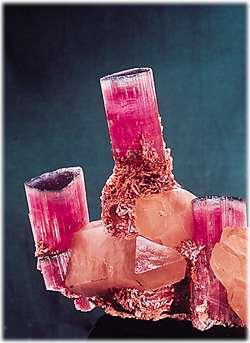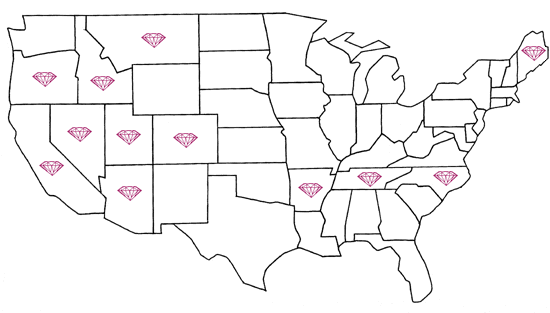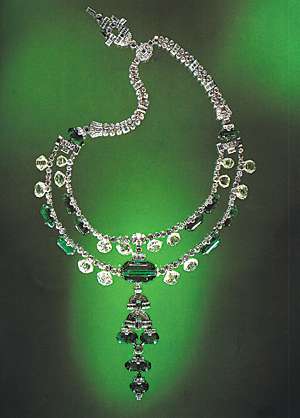January 1996
|
The Gem Spectrum is Pala International’s
free newsletter. Edited by Pala’s own Gabrièl Mattice,
it is filled with interesting articles on various aspects of gems and
minerals.
The letter above is only one of a beautifully compiled collection of correspondence from a book titled Letters to George F. Kunz by Lawrence Conklin. Like the music of the great composers, poignant notes and comments can posthumously capture one’s complete attention and transport the imagination to another place and time. Whether receiving or sending these letters, such respect and kinship was conveyed that one is impressed and humbled by the unpretentious knowledge freely shared by Dr. Kunz and his peers. Accompanying this letter was a list of 118 gems occurring in the USA! It is interesting to note that at that time (1898), red beryl, benitoite, morganite and kunzite among others, had yet to be disclosed. Historically, all 50 states have produced some gem materials but commercial production is limited to only a few areas. By far the largest number of finds, both currently and historically, have been made by amateur collectors, mineralogists and geologists. Here is a brief overview of current (1996) important American deposits in alphabetical order.
ARIZONA for many years has produced a large variety of gemstones including amethyst, azurite, chrysocolla, fire agate, garnet, malachite, obsidian, peridot, petrified wood, and of course turquoise. The Arizona peridot source is located on the San Carlos Indian Reservation and is considered the largest production in the entire world and turquoise from the Sleeping Beauty Mine is considered some of the finest. ARKANSAS is famous for being the only location in the United States that has ever produced diamonds from a pipe (there are many rumors that new pipes are about to be worked commercially in Wyoming and other areas of the Midwest and West, however, these projects are not yet being implemented). Arkansas also produces wonderful quartz crystals popularly known as Herkimer diamonds because of their crystal habit and clarity. One little known fact is that fresh water pearls are also cultivated here in large numbers. CALIFORNIA has a long history of gem production starting with tourmaline. This Pacific coast state has produced tourmaline, benitoite (exclusively), spessartine garnet, abalone pearls, morganite, and some natural blue topaz, California also boasts the distinction of being where the original find of gem kunzite was discovered in 1901. The Himalaya mine has produced Pink and flawless bicolor tourmaline from the late 1800s to the present. In 1972, approximately 30 of the now highly prized and extremely rare “blue caps” from the Queen mine were unearthed. Like the one at right, only 15 found their way into some of the country’s most respected private and museum collections, such as the Smithsonian, American Museum of Natural History and the Houston Museum of Natural History to name a few. As of this printing [1996], future exploration is being discussed to see if benitoite can be mined and distributed on a larger scale. We will keep you informed. COLORADO is known among mineral collectors as an important locality. It has produced smoky quartz, topaz, amazonite, and aquamarines from Mt. Antero. More recently, the famous Alma mine was reopened and produced the finest rhodochrosite in the history of the United States including some which were faceted into gems over 40 carats. This material is too soft for most jewelry wearing but stones of this size are spectacular collector items. IDAHO’S state stone is the star garnet. It is produced in large quantities and sold all over the world. A small find several years ago produced exceptional aquamarine from the Saw Tooth Mountain District. Limited opal mining is producing some fine material. MAINE was long famous as the original discovery for United States tourmaline and is still producing sporadically. In 1972, over one ton of tourmaline was produced at the Denton Mine. However, despite continued mining, little else was recovered. More recently, Mt. Mica has been re-mined and produced some high quality blue-green tourmaline in small sizes. In addition to tourmaline, Maine has produced aquamarine, heliodor, morganite and recently, excellent amethyst. MONTANA is world famous for it’s sapphires from several localities. The most well known are the beautiful blues from the Yogo Gulch. Other varied colors are known from the Rock Creek area and other alluvial deposits. The potential production of large quantities of small size sapphire from Montana is most promising. NEVADA has been a major producer of turquoise for decades and is a strong competitor with Arizona for the finest. Another important deposit is the Virgin Valley area for fine opal. If the opal could be stabilized, it would be among the world’s finest, however, most of this material has a large water content and often crazes.
NORTH CAROLINA is historically known for producing diamond, ruby, sapphire and emerald, as well as being the unique locality for hiddenite which is a rare emerald-green chromium-colored spodumene. Over the last several decades there have been sporadic discoveries of ruby and emerald, including one fine emerald weighing approximately four carats which is on display at Tiffany & Company in New York. More recently new finds of hiddenite have been found. OREGON is one of the largest producers of agates of all sorts, including the famous Thunder Eggs. More exciting for jewelers has been the gem feldspar (sunstone) which has been found in numerous colors over the last several decades, including red and green. A recent find of opal has been interesting; however, it is also subject to crazing. Several large stones have been cut from the material, and to date they have remained stable. TENNESSEE exports the largest quantity of freshwater mussels from North America for use as nuclei for cultured pearls around the world. American Pearl Company is the originator and largest producer of cultured freshwater fancy-shaped pearls. It must be mentioned that 50% of that cultured pearl production is exported to Asian and European wholesalers, who in turn sell them to their customers. The other 50% stays right here in the US, where designers and manufacturers incorporate the beauty of these fancy-shaped pearls (as well as others) into jewelry. Although collectors are the main purchasers of natural pearls (which command a much higher price than cultured), their numbers are much smaller in comparison to cultured pearl buyers. This is because mainly due to a lesser informed public in regards to natural pearls, as well as the strong market saturation and lower price of cultured pearls. UTAH has long produced topaz crystals which are beautiful in color despite fading upon exposure to sunlight. More recently, a very important find of a unique gemstone, red beryl, has been found in the Wah Wah Mountains. The original discovery in the Thomas Mountains (near the topaz) was unimportant, however this new find is producing much larger gem quality crystals. A few cut stones are known for being over four carats, and are a very clean fine quality red. Exploration is going on currently, making this the largest potential commercial gemstone deposit in North America. Today more then ever large global exploration companies, which once specialized primarily in precious metal and ores, are recognizing North America’s gem production as yet another valuable resource to be tapped... but then; isn’t that what Dr. Kunz always said? Many thanks to Lawrence Conklin, New York, for his meticulous and painstaking research. What a great book!
“I hope you will take this opportunity to become a part of the thousands of subscribers that have used The Guide. There is not a better or more complete pricing publication in the industry. I’m sure you can understand by the size of my publication that sample books are not possible. However, if you do decide to order The Guide, your satisfaction is guaranteed. If not satisfied, you may return it for a full refund.” We at Pala International endorse The Guide. In these days of selling to a more informed public, you owe yourself and your staff every advantage. For info contact: Gemworld International, 630 Dundee Rd #235, Northbrook, IL 60062. Phone: 708-564-0555 or Fax: 708-564-0557.
|
|




